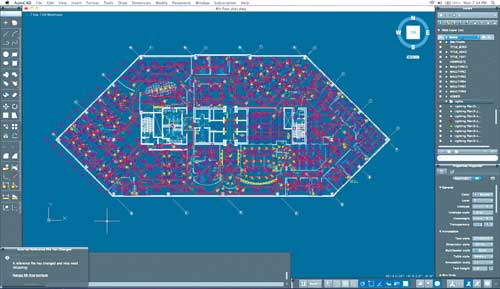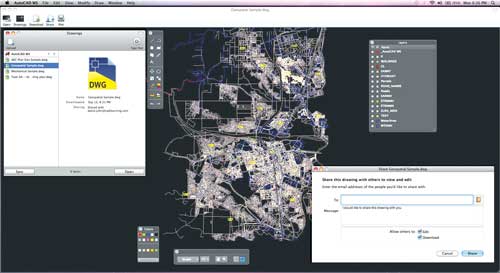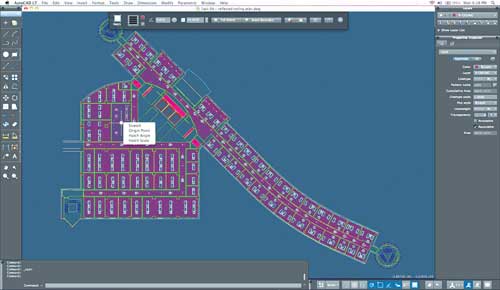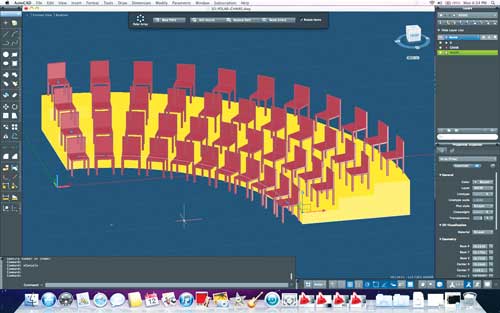Latest News
December 4, 2001
By David Cohn
Last year, Autodesk finally put the rumors to rest, releasing the first native Macintosh version of its flagship CAD software. It had been more than 12 years since the company last produced a version of AutoCAD specifically for the Mac—although ever since Apple switched from Motorola to Intel processors, lots of Mac users had been running versions of AutoCAD using virtual machine software.
Now, one year later, Autodesk has released AutoCAD 2012 for Mac, updating the Mac version to take advantage of many of the same new features and functions introduced in the Windows version of AutoCAD 2012 released earlier this year (see DE, July 2011).

Users are now notified when external references have changed, and the
Layers palette includes Layer Groups, similar to Layer Filters in the Windows
version.
AutoCAD 2012 for Mac looks much different than its Windows counterpart. Instead of the ribbon interface, AutoCAD for Mac puts its tools where Mac users expect to find them: in the Apple menu bar. In addition, the Mac version uses a number of palettes docked to the left and right of the drawing canvas.
By default, the Tool Sets palette appears on the left, while the Layers and Properties Inspector palettes are docked on the right. There are also Command Line and Status Bar palettes across the bottom. All of these palettes can be dragged around the screen, docked in other locations, and collapsed in various ways.
We noted that the most important aspects of AutoCAD—100% DWG file compatibility and robust customization and support for AutoLISP and ObjectARX—were most definitely hallmarks of the Mac version as well. What’s more, AutoCAD 2011 for Mac introduced other exclusive features, such as a set of viewport controls located in the upper-left corner of each drawing viewport, and support for multi-touch gestures. Those viewport controls eventually found their way into the Windows version of AutoCAD 2012; the gestures remain exclusive to the Mac.
New Features
Although some aspects of AutoCAD 2012 for Mac remain exclusive to the Mac, virtually all of the improvements in AutoCAD 2012 have made their way into the new Mac release. For example, the user coordinate system (UCS) icon can be selected and manipulated, making it much easier to adjust the UCS, particularly when working in 3D.
AutoCAD 2012 for Mac also includes auto-complete. As you type at the program’s command prompt or dynamic input field, AutoCAD displays a list of commands, system variables, or command aliases matching what you’ve typed thus far. You can then quickly select from the list.

AutoCAD WS for Mac lets you edit DWG files on your Mac and collaborate
in real time with other team members, using the web or mobile versions of
AutoCAD WS or an actual copy of AutoCAD or AutoCAD LT.
Other new AutoCAD 2012 features, such as enhanced multifunctional grips, better control over multi-leaders, the new Blend command, improved join functionality, and previews when using the Fillet or Chamfer commands or when working with surfaces have also been included in AutoCAD 2012 for Mac. The Copy command also includes the new Array option, so you can create a linear array of independent objects.
Speaking of arrays, associative arrays—potentially one of the biggest AutoCAD productivity improvements in years—are also included in the new Mac release. Rather than simply making duplicate copies of selected objects arranged in a rectangular or circular pattern, there are now three separate commands for creating rectangular arrays, polar arrays or path arrays. Path arrays distribute items along a path formed by objects such as lines, arcs, polylines or helixes, and can follow 2D or 3D paths. All three types of arrays can also include multiple levels.
Visors to the Rescue
If there were any significant complaints about the initial release of AutoCAD for Mac, they focused more on what was missing. For example, AutoCAD 2011 offered a huge improvement in the way users interacted with hatch patterns and gradient fills, enabling users to preview and adjust these objects before committing changes to the drawing. Much of this capability relied on the ribbon, but because the Mac doesn’t have a ribbon interface, AutoCAD 2011 for Mac used a dialog box—similar to the way things worked in AutoCAD 2010 and earlier releases.
Happily, Autodesk has found an excellent alternative to the ribbon: contextual visors. Visors aren’t new. AutoCAD 2011 for Mac used a visor when creating or editing multi-line text. But in AutoCAD 2012 for Mac, visors are now provided for other operations as well. For example, when creating or modifying hatch patterns or gradient fills, you no longer see a dialog. Rather, the program displays a visor containing controls for selecting the hatch pattern, adjusting its angle and scale, and so on. You can then preview changes made to the hatch or fill before saving those changes to the drawing.

While offering the more limited toolset of AutoCAD LT, AutoCAD LT for
Mac 2012 sports the same native Mac interface as AutoCAD 2012
for Mac—and benefits from new features, such as the Hatch Editing contextual visor.
When modifying associative arrays, you see a visor containing tools for changing the base point, editing the source object, replacing items in the array, and resetting the array—similar to those that appear in the ribbon when working in the Windows version. Missing, however, are visor-based controls for adjusting the spacing between arrayed objects or the number of objects in the array; for that, you’ll have to rely on grip editing.
There’s also a visor that displays when working in a paper space layout so you can add a new viewport, edit the page setup, or print the current layout. Another displays when you select an external reference so you can edit, open or clip the xref and another. You can also now double-click to edit an external reference in place, and AutoCAD 2012 for Mac now notifies you when external references change.
AutoCAD WS Enables Free CAD Sharing With the release of AutoCAD and AutoCAD LT for Mac 2012, Autodesk has also released AutoCAD WS for Mac, a native Macintosh version of the software, available as a free download from the Mac App Store. Both the Windows and Macintosh versions of AutoCAD and AutoCAD LT 2012 include tools to upload drawings to AutoCAD WS. After setting up a free online account, you can access your drawings using any version of AutoCAD WS and, if you choose, share them with others. You can set permissions to let others view, edit or download drawings. Once downloaded, a drawing can be opened using AutoCAD or AutoCAD LT. AutoCAD WS includes tools to pan and zoom, control layers, and draw basic geometry such as lines, circles, polylines and text. You can also move, copy, rotate, scale and erase objects, measure distances and areas, and switch between model space and paper space. The web-based version includes additional tools not found in the mobile app, while the capabilities of the new Mac version fall somewhere in between. For example, both the web-based and Mac versions let you plot drawings to PDF or DWF, while the Mac and web-based versions include Ortho mode and object snap. The Mac version lacks timeline capabilities, however. All versions let you co-edit drawings with others at the same time, even with people who don’t have a copy of AutoCAD or AutoCAD LT. That’s definitely one of the biggest features of this cool little app. |
Filling Some Gaps
Some users complained that the icons in the Toolset and Status Bar in AutoCAD 2011 for Mac were too small. Happily, users can now easily adjust these from within the Application Preferences dialog. In the 2011 Mac release, a Content palette made up for some lost functionality because of the absence of the Tool palette, by letting you organize and access frequently used blocks. But you could only add blocks to a drawing by clicking on the block in the Content palette. Now, you can either double-click or drag-and-drop the block from the Content palette to the drawing.
The new Mac release also goes a long way toward filling other gaps that we had noted last year. For example, AutoCAD 2011 for Mac lacked layer filters. To remedy that, AutoCAD 2012 for Mac now offers layer groups within the Layers palette. After creating a layer group, you can add layers to a group by simply dragging and dropping from the main layer list. You can then change the status of all layers in a group with a single click.
AutoCAD 2012 for Mac also now includes a Batch Publish feature nearly identical to the Publish command in AutoCAD, and you can publish to the printer named in each layout page setup—or to single- or multi-sheet PDF files. The Export command also now supports PDF, in addition to ACIS, STL, EPS, DXX, BMP and DWG, and lets you choose what to export (the display, drawing extents or a window). It also lets you override the current page setup. The new Mac release also includes the Drawing Recovery Manager.

AutoCAD 2012 for Mac incorporates most of the new features in AutoCAD
2012, such as associative arrays, and improves upon the previous release with
the addition of tools such as contextual visors.
Unfortunately, there is still a pretty long list of features and functions totally missing from AutoCAD 2012 for Mac. For example, while you can insert and manipulate dynamic blocks, you still cannot create or edit dynamic blocks in the Block Editor. There’s also no Action Recorder, Batch Standards checker, Layer Translator, Sheet Set Manager, AutoPublish, eTransmit or drawing object hyperlink capability.
Good Enough?
AutoCAD 2012 for Mac supports network licensing. Prospective users can download a free 30-day trial version, and existing AutoCAD 2012 users can even activate AutoCAD 2012 for Mac using the same license number and activation code, so multi-seat licenses can be shared. You can even use the License Transfer Utility to import and export a stand-alone license between Windows and Macintosh systems.
Because it represented a complete rewrite of AutoCAD as a native OS X application, AutoCAD 2011 for Mac was essentially a first release. This revision smooths out many of the rough spots. There are still some missing features that could be showstoppers for some, who may elect to run AutoCAD 2012 on their Macs using a virtual machine. But for many, AutoCAD 2012 for Mac provides lots of power—and may be a perfect native Macintosh solution.
AutoCAD LT for Mac 2012 For example, users can create and modify drawing objects, add text and dimensions, and attach external references and image files. But because AutoCAD LT is strictly a 2D program, it lacks the ViewCube and there are no in-canvas viewport controls. There are also no 3D modeling or rendering tools, and no support for AutoLISP or Object ARX—but this is true for both the Windows and Mac versions. So while AutoCAD LT for Mac 2012 also lacks a number of other features found in the Windows version, such as Sheet Sets and eTransmit, the list is not quite as long simply because LT doesn’t include all of the features found in the full version of AutoCAD. Still, AutoCAD LT for Mac 2012 does support gestures and can use Cover Flow to locate drawings. AutoCAD LT for Mac 2012 also takes advantage of the same contextual visors for functions, such as hatch editing, manipulating external references, and adjusting associative arrays as AutoCAD 2012 for Mac. It also has largely the same system requirements. Unlike the Mac version of AutoCAD or even the Windows version of AutoCAD LT, however, prospective customers cannot download a free trial version of AutoCAD LT for Mac. Currently, AutoCAD for Mac is available only from Apple’s Mac App Store in the US and Canada. There is no subscription option, and AutoCAD LT for Mac does not support network licensing. But it also does not need to be activated. You can begin using the software as soon as it finishes downloading. If your drawing needs are limited to 2D, AutoCAD LT for Mac may be an ideal native Macintosh solution. |
MORE INFO
Autodesk Inc.
AutoCAD 2012 for Mac 2012
Price: $3,995 (full system); $450 (annual subscription)
System requirements:
- Computer: Apple Mac Pro 4,1 or later; MacBook Pro 5,1 or later (MacBook Pro 6,1 or later recommended); iMac 8,1 or later (iMac 11,1 or later recommended); Mac mini 3,1 or later (Mac mini 4,1 or later recommended); MacBook Air 2,1 or later; MacBook 5,1 or later (MacBook 7,1 or later recommended)
- Operating System: Mac OS X v10.6.4 or later
- CPU: 64-bit Intel processor
- Memory: 3GB RAM (4GB recommended)
- Disk space: 2.5GB free disk space (3GB recommended)
- Video: 1280x800 display with true color (1600x1200 with true color recommended)
David Cohn is the technical publishing manager at 4D Technologies and the author of that company’s CADLearning eLearning courses for AutoCAD. He also does consulting and technical writing from his home in Bellingham, WA. He’s a contributing editor to Desktop Engineering and the author of more than a dozen books on AutoCAD, a program that he has used for more than 25 years. Contact him via email at [email protected] or visit his website at DSCohn.com.
Subscribe to our FREE magazine, FREE email newsletters or both!
Latest News
About the Author
David Cohn is a consultant and technical writer based in Bellingham, WA, and has been benchmarking PCs since 1984. He is a Contributing Editor to Digital Engineering, the former senior content manager at 4D Technologies, and the author of more than a dozen books. Email at [email protected] or visit his website at www.dscohn.com.
Follow DE





